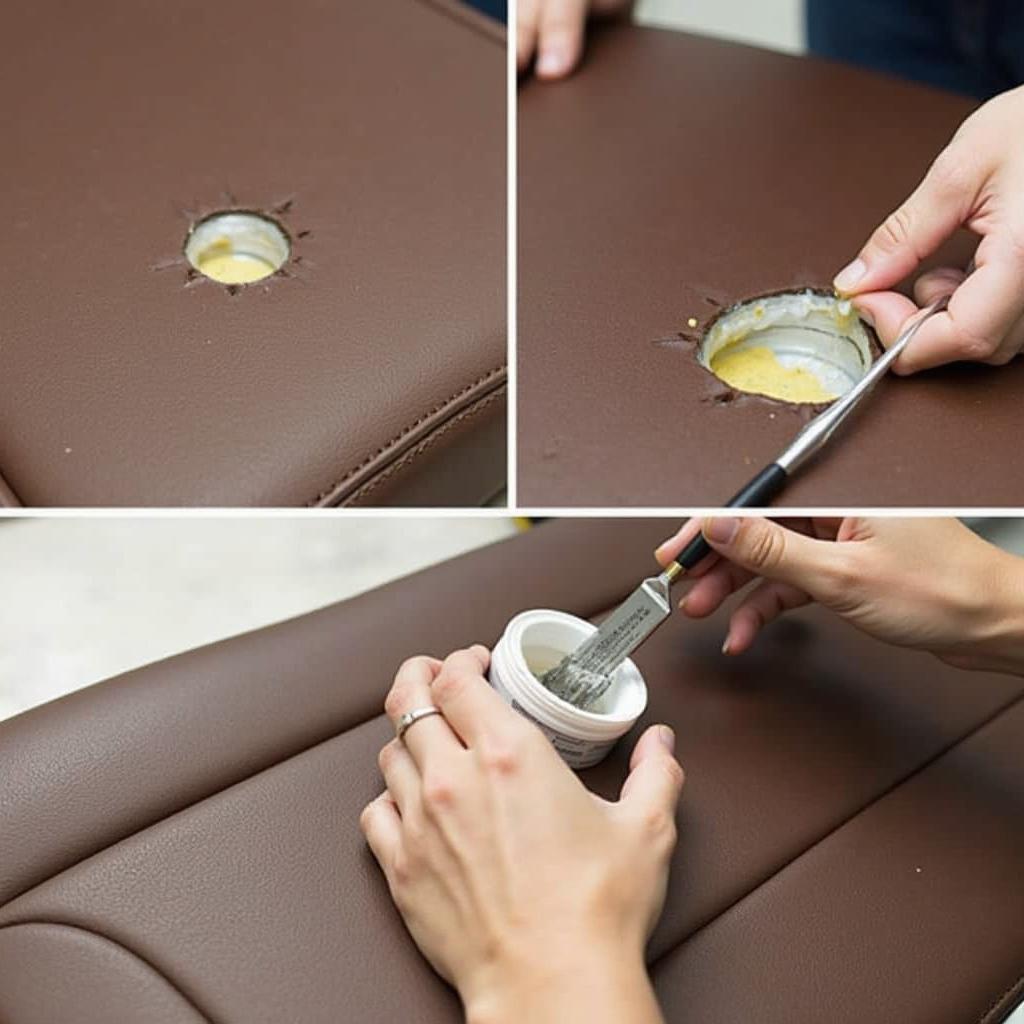Leather car seats lend a touch of luxury and sophistication to any vehicle. However, over time, they can be susceptible to wear and tear, with holes being a common problem. Whether it’s a small puncture from a sharp object or a larger tear caused by wear, knowing how to repair holes in leather car seats can save you from costly replacements and maintain the pristine appearance of your car’s interior. This comprehensive guide will walk you through the steps, techniques, and expert tips to effectively repair those unsightly holes and bring your leather seats back to life.
Identifying the Type of Hole and Assessing the Damage
Before embarking on the repair journey, it’s crucial to identify the type and extent of the damage. This will determine the appropriate repair method and materials needed.
- Punctures: These are small holes caused by sharp objects like pens, keys, or tools.
- Tears: These are longer, jagged openings often caused by sharp objects or rough use.
- Rips: These are larger tears that can occur at seam lines or weak points due to wear and tear.
Once you’ve identified the type of hole, assess the surrounding area for any additional damage like scratches or cracks. This will give you a complete picture of the repair work required.
Gathering Your Leather Repair Toolkit
Having the right tools and materials is essential for a successful repair. Here’s a list of what you’ll need:
- Leather Repair Kit: These kits are readily available online and at auto parts stores. They typically include a color-matched filler paste, backing fabric, adhesive, a palette knife, and a grain paper.
- Rubbing Alcohol: Used for cleaning the damaged area and ensuring proper adhesion of the filler.
- Microfiber Cloths: Essential for applying rubbing alcohol, cleaning the surface, and buffing the repaired area.
- Scissors: For trimming the backing fabric and grain paper to size.
- Heat Gun or Hair Dryer: Used to speed up the drying process of the filler paste.
- Leather Conditioner: Applying a high-quality leather conditioner after the repair helps restore the leather’s suppleness and prevents future cracking.
Step-by-Step Guide to Repairing Holes in Leather Car Seats
Now that you have your tools and materials ready, let’s dive into the repair process:
-
Clean the Damaged Area: Start by thoroughly cleaning the damaged area and the surrounding leather with rubbing alcohol and a microfiber cloth. This removes dirt, debris, and any oils that might hinder adhesion.
-
Prepare the Backing Fabric: For larger holes or tears, cut a piece of backing fabric slightly larger than the hole. This will provide support and prevent the filler from sagging.
-
Apply the Leather Filler: Using the palette knife, carefully apply the leather filler paste to the hole, ensuring it fills the entire cavity evenly. If you’re using backing fabric, apply a thin layer of adhesive to the fabric and carefully place it over the hole, pressing it down firmly.
-
Create the Leather Grain Pattern: If your leather seat has a distinct grain pattern, you can replicate it using grain paper. Place the grain paper over the wet filler and gently press it down. You can use a heat gun or hairdryer to slightly melt the filler, allowing it to take on the texture of the grain paper.
 Applying Leather Filler to a Car Seat Hole
Applying Leather Filler to a Car Seat Hole
-
Dry and Sand the Filler: Allow the filler to dry completely. This may take a few hours depending on the type of filler used. Once dry, use fine-grit sandpaper to smooth out any rough edges and blend the repaired area seamlessly with the surrounding leather.
-
Apply Colorant (If Necessary): If the leather repair kit comes with a colorant, use it to match the repaired area with the rest of the seat. Apply thin coats, allowing each coat to dry before applying the next, until you achieve the desired color match.
-
Apply Leather Conditioner: Once the repaired area is completely dry and smooth, apply a high-quality leather conditioner to the entire seat. This helps restore the leather’s natural oils and prevents future cracking.
Expert Tips for a Flawless Finish
- Practice Makes Perfect: If you’re unsure about tackling a large hole or tear, practice on a hidden area of the seat or a piece of scrap leather first.
- Patience is Key: Allow ample drying time between each step, especially when applying the filler and colorant.
- Match the Grain: When replicating the leather grain, ensure the direction of the grain pattern matches the surrounding leather for a seamless look.
“It’s amazing how even small details like matching the grain pattern can make a significant difference in the final result of a leather repair,” says John Miller, an experienced automotive upholstery specialist at Miller’s Auto Trim. “Taking the time to get these details right will make your repair job look professional and almost invisible.”
Preventing Future Damage
While repairs can effectively address existing holes, prevention is always better than cure. Here are some tips to prevent future damage to your leather car seats:
- Regular Cleaning and Conditioning: Keep your leather seats clean and moisturized by wiping them down regularly with a damp cloth and applying a leather conditioner every few months.
- Avoid Sharp Objects: Be mindful of what you carry in your pockets and avoid placing sharp objects on your seats.
- Use Seat Covers: Consider using seat covers, especially if you frequently transport pets or children.
Conclusion
Repairing holes in your leather car seats might seem daunting, but with the right approach and a little patience, you can achieve professional-looking results and restore your car’s interior to its former glory. Remember to assess the damage carefully, gather the necessary tools and materials, and follow the step-by-step guide diligently.
By taking the time to repair those pesky holes, you not only enhance the aesthetic appeal of your vehicle but also protect your investment and enjoy the luxurious comfort of leather seats for years to come. And remember, if you’re ever unsure about tackling a complex repair, don’t hesitate to seek professional help from a qualified automotive upholsterer.
FAQs
Q: Can I use superglue to repair a hole in my leather car seat?
A: While superglue might seem like a quick fix, it’s not recommended for leather repair. Superglue dries too rigidly and can cause the leather to crack further. It’s best to use a flexible leather filler designed for such repairs.
Q: How long does it take for the leather filler to dry completely?
A: Drying time varies depending on the type of filler and environmental factors like humidity. Most fillers take a few hours to dry completely. It’s best to refer to the manufacturer’s instructions for specific drying times.
Q: Can I repair a hole in a heated or cooled leather car seat?
A: Yes, but it’s essential to choose a leather filler compatible with heated and cooled seats. These fillers are designed to withstand temperature fluctuations without cracking or losing adhesion.
Q: Where can I find the right color match for my leather car seats?
A: Most leather repair kits come with a range of colorants to match common leather shades. You can also find specialized leather dyes at automotive upholstery stores or online. If you’re unsure, consult with a professional for color matching.
Q: Can I still repair a hole if the leather is ripped or torn around it?
A: Yes, repairing holes with surrounding rips or tears might require additional steps like stitching or using a leather patch, but it’s definitely possible to achieve a successful repair.
Looking for more information on car seat repair? Check out these helpful resources:
- How to Repair a Burn Hole in a Leather Car Seat
- How to Repair Burn Holes in Leather Car Seats
- Where to Get Leather Car Seat Repair
- How to Repair Hole Leather Car Seats
- Car Seat Repair Near Me
Need professional assistance? Contact our team on WhatsApp: +1(641)206-8880, Email: [email protected]. We have a 24/7 customer support team ready to assist you.

